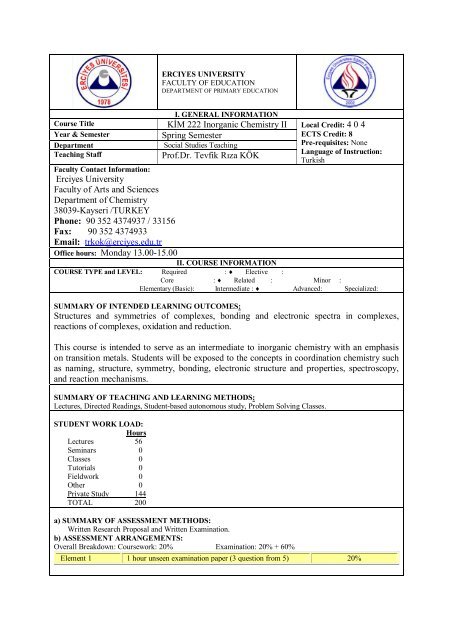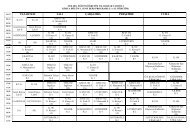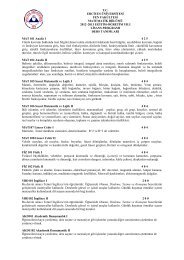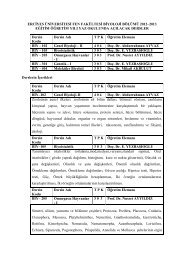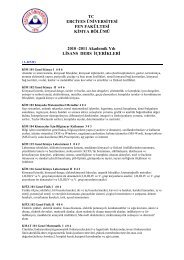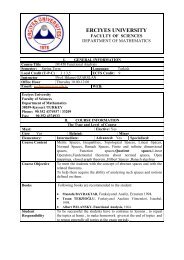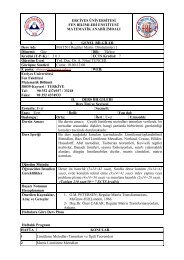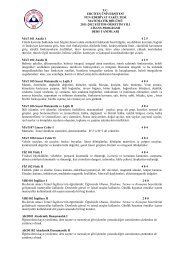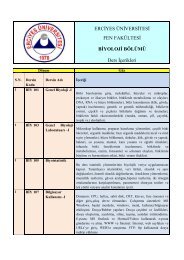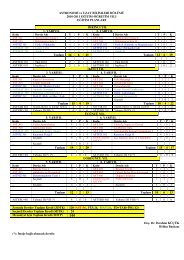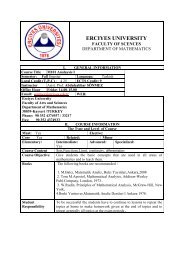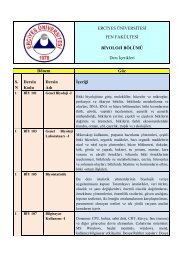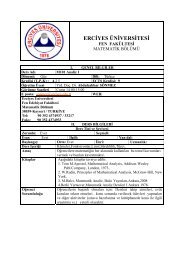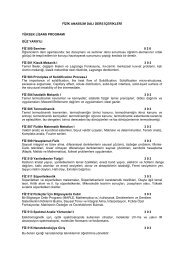CHEM 222 Inorganic Chemistry II
CHEM 222 Inorganic Chemistry II
CHEM 222 Inorganic Chemistry II
Create successful ePaper yourself
Turn your PDF publications into a flip-book with our unique Google optimized e-Paper software.
ERCIYES UNIVERSITYFACULTY OF EDUCATIONDEPARTMENT OF PRIMARY EDUCATIONI. GENERAL INFORMATIONCourse TitleKİM <strong>222</strong> <strong>Inorganic</strong> <strong>Chemistry</strong> <strong>II</strong>Year & SemesterSpring SemesterDepartment Social Studies TeachingTeaching StaffProf.Dr. Tevfik Rıza KÖKLocal Credit: 4 0 4ECTS Credit: 8Pre-requisites: NoneLanguage of Instruction:TurkishFaculty Contact Information:Erciyes UniversityFaculty of Arts and SciencesDepartment of <strong>Chemistry</strong>38039-Kayseri /TURKEYPhone: 90 352 4374937 / 33156Fax: 90 352 4374933Email: trkok@erciyes.edu.trOffice hours: Monday 13.00-15.00<strong>II</strong>. COURSE INFORMATIONCOURSE TYPE and LEVEL: Required : ¨ Elective :Core : ¨ Related : Minor :Elementary (Basic): Intermediate : ¨ Advanced: Specialized:SUMMARY OF INTENDED LEARNING OUTCOMES:Structures and symmetries of complexes, bonding and electronic spectra in complexes,reactions of complexes, oxidation and reduction.This course is intended to serve as an intermediate to inorganic chemistry with an emphasison transition metals. Students will be exposed to the concepts in coordination chemistry suchas naming, structure, symmetry, bonding, electronic structure and properties, spectroscopy,and reaction mechanisms.SUMMARY OF TEACHING AND LEARNING METHODS:Lectures, Directed Readings, Student-based autonomous study, Problem Solving Classes.STUDENT WORK LOAD:HoursLectures 56Seminars 0Classes 0Tutorials 0Fieldwork 0Other 0Private Study 144TOTAL 200a) SUMMARY OF ASSESSMENT METHODS:Written Research Proposal and Written Examination.b) ASSESSMENT ARRANGEMENTS:Overall Breakdown: Coursework: 20% Examination: 20% + 60%Element 1 1 hour unseen examination paper (3 question from 5) 20%
Final Exam 1 hour unseen examination paper (5 question from 7) 60%POLICIES:Attendance: Students are required to attend all classes and to submit their essays and assignments on time. Themore you participate, the more you will learn - and only you can learn the material - I cannot learn it for you. Soparticipate in class! Use my office hours! Use email to ask questions! You are expected to do the assignedreadings before coming to class. Readings are listed at the end of page. You should read these critically, askingquestions as you go - What does this mean (do I understand it)? Why is it important to the study of researchmethodologies? When and how would I use this information? How does this information relate to otherinformation we've learned in class (or in other classes)? As you do the assigned readings, ask yourself thefollowing questions: What did I learn that I didn't know before? What did I already know, but gained a betterunderstanding of? What am I still confused about?Lateness: Late attendances and submission will be not accepted. Students should not ask for exceptions.Academic Integrity: All students are expected to adhere to University policies concerning scholastic integrity.Any form of scholastic dishonesty will not be tolerated, Scholastic dishonesty includes, but is not limited to,cheating, plagiarism, falsifying academic records, and any act designed to give unfair academic advantage to thestudent.COURSE CONTENTS (PROGRAMME OF STUDY/SYLLABUS)WEEK1CHAPTER TOPICSIntroduction to coordination chemistry: descriptionand nomenclature of complexes2 Structures and symmetries of complexes3 Structures and symmetries of complexes4 Bonding in complexes: valence bond theory5 Bonding in complexes: crystal field theory6 Bonding in complexes: molecular orbital theory7 Term symbols8 MID-TERM EXAM9 Electronic structure and spectra of complexes10 Electronic structure and spectra of complexes11 Reactions of complexes12 Reactions of complexes13 Oxidation and reduction14 Oxidation and reductionFINAL EXAMRECOMMENDED READING:1. Tunalı, N.K. and Özkar, S., Anorganik Kimya, Gazi Üniversitesi Yayın No: 185,Ankara, Turkey, 1997.2. Shriver, D.F., Atkins, P. W. and Langford, C.H., <strong>Inorganic</strong> <strong>Chemistry</strong>, OxfordUniversity Press, Oxford, UK, 1990.3. Özkar, S., Çetinkaya, B., Gul, A. and Gök, Y., Anorganik Kimya, Bilim Yayıncılık,Ankara, 2003. (Translated from: Shriver, D.F. and Atkins, P.W., <strong>Inorganic</strong> <strong>Chemistry</strong>,Oxford University Press, Oxford, 1999).4 Miessler, G., and Tarr, D., <strong>Inorganic</strong> <strong>Chemistry</strong>, Prentice Hall (2nd ed.), New Jersey,USA, 1999. Translated in Turkish: Patat, Ş., Kristal Katılar/İnorganik Kimya, Palme
Yayıncılık, Ankara, 2002, Translating Editor; Karacan ,N.and Gürkan, P.5 Ölmez, H. And Yılmaz, V.T., Anorganik Kimya, Otak Form-Ofset Basım San. ve Tic. (3. ed.), Samsun, Turkey, 2004.


